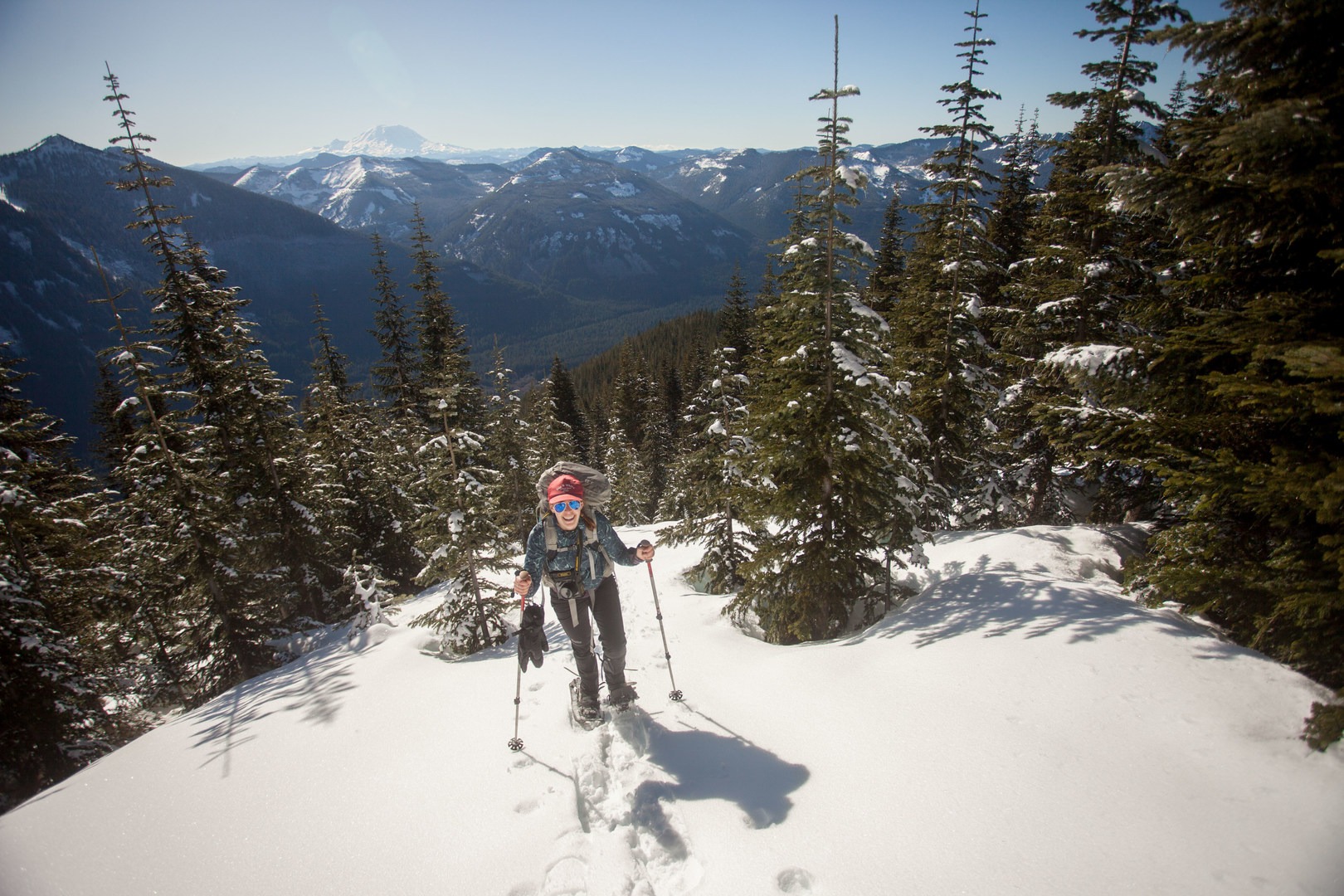You are here
West Granite Mountain, or its more colorful name "Tusk O'Granite", is only a short drive away from Seattle, and the trailhead is only a few hundred feet from I-90. However, especially in the winter, the snow-covered landscape damps down the sounds of the highway, and shortly after you've begun, you'll forget how close you are to civilization. West Granite is an interesting mountain because it's along the I-90 corridor in the Mountains to Sound Greenway - a heavily visited region - but West Granite rarely gets travelers as it has no maintained trails to its summit. In the summer, climbers have to scramble up a fair amount of talus to summit, but in the winter, snowshoers can blaze their own trail up without too much trouble.
This climb is a great choice if you've got a fair amount of snowshoeing and winter-travel experience and are trying to get to some less-visited area. This climb is not for new winter travelers, as it requires a lot of avalanche safety decisions!
If you're feeling extra adventurous, you can traverse from the summit of West Granite over to Granite Mountain proper, though this will expose you to a lot more avalanche terrain, and you'll need a lot of experience to make this decision safely.
Notes
- Seasonality: There will generally be snow on this peak between late October and early June, though conditions will be best for snowshoeing between mid-November and May.
- Gear
- Mandatory: Avalanche beacon, shovel, probe, and avalanche rescue know-how
- Traction/Floatation: Depending on the snowpack, you may need snowshoes, microspikes, or even crampons and an ice axe. Research trip reports from the area before you go, and know your limits, turning back if the conditions exceed your experience and/or gear.
- Winter travel gear: Including lots of layers, the 10 Essentials, and anything else you need to stay comfortable!
- Avalanche Safety: Granite Mountain is extremely dangerous avalanche terrain, and multiple people have died here, as the winter route goes through a few terrain traps. West Granite Mountain has less avalanche exposure than its eastern neighbor, but it's still dangerous, and you should always check the Northwest Avalanche Center report and bring avalanche safety gear.
- Routes: There are at least two routes up West Granite. This report will describe both routes (the south face and the west ridge), as well as the traverse to Granite.
- Navigation: There are no trails to the summit, and it's rarely visited, which means you'll almost certainly be breaking your own trail. Plan your route beforehand and a bring a GPS to help you get up!
The Climb
The trail leaves the trailhead and immediately begins climbing steeply. You'll stay left at the Granite Mountain junction after a mile from the trailhead, and continue up trail across a creek. At around 2,900' (and after 1.5 miles) you'll reach a decision-point. Do you take the shorter and bushier South Face route or the longer and more avalanche-prone West Ridge?
South Face Route: You'll leave the trail and head straight north, climbing through alternatingly thick-and-thin alder groves and trees for around 1,700 feet, before coming into some some wider glades in the trees. Shortly after the glades begin, you'll reach a knob at 5,100 feet and you'll be able to see the mountains around you. From here, the route is straightforward - continue north up the sloping ridge to the summit of West Granite!
West Ridge Route: This route is longer, and you'll follow the Pratt Lake trail as it contours and curves northward. After 3.5 miles from the trailhead, you'll be east of Ollalie Lake and below some big bowls on the west side of West Granite. Depending on avalanche conditions, you can head up the bowls or hit the ridge a bit further west. Either way, you're trying to get on the ridge that will lead you straight west-southwest to West Granite. This ridge is pretty steep and treed, so take your time as you climb through this section. Soon you'll be on the summit!
You've reached the summit, enjoy the views all around you! From the summit, you have two options: you can head down, or continue traversing to Granite Mountain. Before you make this decision, think about how you're feeling and how the snow has been behaving. If conditions are changing or you've seen any warning signs from the snow (like slides or sluffs or rollerballs), keep it conservative. This area can be sketchy in the wrong conditions!
Heading down:
If snow conditions are stable, you can head east to the saddle between West Granite and Granite and then plunge-step down the big meadow, all the way back down to the trail you came in on. Be careful of the various creeks that begin in this area!
If you're worried about the snow conditions, you can retrace your steps and descend your climbing route, which should have less avalanche terrain exposure.
Traversing to Granite
You'll head straight east, trending slightly south, to the saddle between West Granite and Granite. From this saddle, you'll head up the obvious ridge to Granite, heading southeast. This ridge can get heavily corniced, wind-loaded, and/or icy, so be careful here! You'll soon reach the summit and the lookout, which is closed in the winter.
Descending from Granite: Do not follow the summer trail, it's unnecessarily out of the way and exposes you to more avalanche risk than is necessary. Instead, you'll head down the southwest ridge. From here, you can drop west to into the drainage you came from, or head south/southeast down the avalanche chutes. Either way, watch your GPS and angle yourself toward the nearest trail. Around 3,000 feet you should be getting to a trail.
All of these different variations will get you back to a trail! Follow it downhill back to the trailhead. Congratulations on a great snowshoe!
Logistics + Planning
Current Weather: Powered by Dark Sky






























Comments
Sign In and share them.